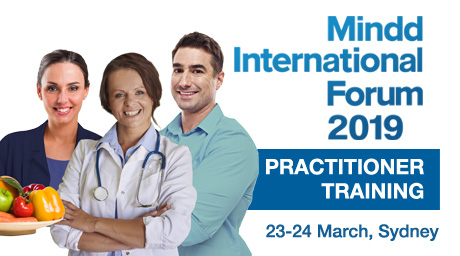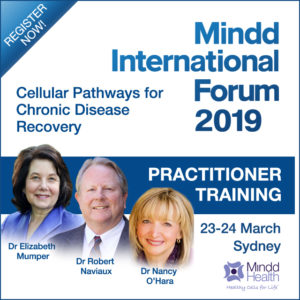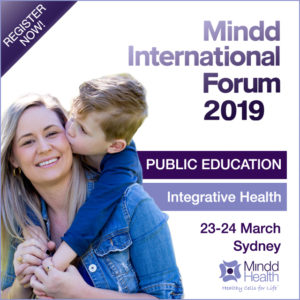The Autism Research Institute asked Dr. Nancy O’Hara a selection of questions, frequently asked by parents, regarding their children’s health and wellbeing. Stimming is one of them.
Mindd International Forum, 23-24 March (Live in Sydney, Australia and Livestreaming globally)
Certified practitioners who pass the assessment will be listed at mindd.org. A certificate of completion will be provided for CPD applications.
Dr. Nancy O’Hara is a board certified Pediatrician. She also has a Master’s degree in Public Health and entered general practice in 1993. Since 1999 she has dedicated her functional medicine practice to the integrative and holistic care of children with chronic illness and neurodevelopmental disorders. She is also a leader in the training of clinicians and is a member of the Mindd Foundation Advisory Board.
Many of the topics covered below will be discussed in Dr O’Hara’s Presentations at the 2019 Mindd Forum.
Q: Is there a relationship between the MTHFR gene mutation and children’s neurological disorders?
Dr O’Hara: We fondly call MTHFR the mother gene because it interferes with folate metabolism. Folate is a B vitamin and we get it in green leafy vegetables and other food. It gets broken down in the body to two metabolites; folinic acid and then methyltetrahydrofolate. Methyltetrahydrofolate is very important in the methylation and sulfation pathway of glutathione so it’s really important for brain development and detoxification in general.
Since they’re very important for the healthy functioning of the brain, these metabolites of folate are vital to decrease anxiety, tics, OCD and other childhood neurological symptoms. It has been shown that if you have a defect in the MTHFR gene, you are less able to metabolize or break down folate completely into folinic acid and methyltetrahydrofolate. This means you are more likely to have problems with detoxification, anxiety, tics, brain fog, and cognitive delays.
Q: What is Stimming?
Dr O’Hara: Stimming is defined as one of the symptoms commonly experienced by individuals with Autism Spectrum Disorder, although it is observed in about 10 per cent of non-autistic children. Common forms of stimming among autistic people include hand flapping, body spinning, rocking, lining up or spinning toys and other objects, echolalia, perseveration and repeating rote phrases. Other kinds of stimming can include humming, covering and uncovering ears, skin rubbing, finger tapping or repetitive blinking.
Q: Are there triggers for Stimming and how do you identify them in practice?
Dr O’Hara: I always look at all parts of the child’s history or physical exam to figure out what could be causing the stimming. For instance, if OCD, perseveration or stimming behaviors are due to yeast then they’ll usually have other yeast overgrowth behaviors. These could be brain fog, rashes, tinea, ringworm or redness on either the cheeks of child’s bottom or face. You might also see food cravings for carbohydrates and sugars. If those are going on then I would really focus on looking at yeast as a trigger.
I would also look at whether those behaviors were a sudden onset following a strep mycoplasma or a virus. That would lead me to the cause being something called PANS or PANDAS which is Pediatric Acute-onset Neuropsychiatric Symptoms associated with Streptococcus. That would require a blood test or at the very least a visit to a practitioner to further enquire.
A folate deficiency can also worsen stimming, so if MTHFR is possible that’s something to consider.
There are also dietary triggers such as gluten and casein. I can definitely see an increase in stimming with these present and if parents haven’t tried removing these from their child’s diets it’s definitely worth considering. Gluten and casein need to be taken out 100 per cent, not 99 per cent.
Q: How long do I need to do the gluten and casein free diet to know if it’s helping?
Dr O’Hara: Gluten needs to be eliminated for at least three months because it takes that long for the antibodies to get out of the system. I know that everybody’s always having food parties but if you ingest these foods even once then you’re back to square one and have to start counting the time since cutting them out all over again.
Casein needs to be eliminated for at least three weeks but it’s best to try it with gluten at the same time, so for three months too. The other caveat is if you’re replacing gluten-containing junk with gluten-free junk you’re not doing yourself or your child any favors. The priority needs to be removing junk, so when you do that diet or any diet the more you can focus on food which is on the outside of the aisles in the grocery store the better. That’s good fruits, vegetables, proteins, and healthy fat and the healthier and more successful you’ll be.
Q: Can we supplement our children with fish oil and what’s the best essential fatty acids to take?
Dr O’Hara: The most important thing to consider with fish oil is if one of your children has a soy allergy, as some fish oils have a soy base. The other more important thing is to ensure a good quality fish oil as there can be mercury. Nordic Naturals has a very good quality fish oil.
The next part is you want to look at a complete essential fatty acid profile so that it has EPA as well as DHA. Little babies need more DHA but as your child ages, certainly over the age of 3, you need a combination of DHA and EPA. Some fish oils may also include GLA which is another essential fatty acid.
The biggest mistake we make is under dosing essential fatty acids. Whilst there are factors that need to be considered when prescribing fish oil such as whether a patient has oil in their stool, if they bruise easily or get frequent nosebleeds, the dose can still be prescribed quite high. The minimum is two thousand milligrams but there are studies from Oxford and Harvard showing that kids may need upwards of ten thousand milligrams. It’s best to get the maximum anti-inflammatory benefits as well. Just ensure that the supplements don’t contain vitamin A if they are going to be taken at high doses, as Vitamin A has its own upper limit which is unsafe to exceed.
Q: How do you treat eczema and what are some non-steroidal treatment alternatives?
Dr O’Hara: With eczema, I always look for the source first. It can be foods a lot of the time, and although it seems tough to find, it’s worth persisting. The second thing I look at is molds in the environment or detergents.
Natural treatment options can be extremely helpful. First, try putting baking soda in the bathtub and then patting the child dry afterwards instead of rubbing with a towel. Then, apply an emollient which can be either a cream or an ointment. In addition to emollients, non-steroid anti-inflammatories can be taken such as quercetin or resveratrol. Aloe vera is always a great tool to use topically as well as to ingest.
Dr Nancy O’Hara’s Presentations include:
- Chronic Immune System Activation/Chronic Inflammatory Response Syndrome
- POTS & Dysautonomia
- PANS, PANDAS & Beyond
- Lyme: It is in Australia
- Trust Your Gut: Celiac & Non-Celiac Gluten Sensitivity
- Making the Grade: ADHD without drugs
Learning Objectives for Dr Nancy O’Hara’s Presentations
- Identifying chronic inflammatory responses that may be triggered by biotoxins, tick bites, toxic metabolic products, extracellular ATP and cell wall fragments from molds.
- Exploring the complexities of postural orthostatic tachycardia syndrome and identify treatment strategies.
- Learning to identify PANS and PANDAS and the associated symptoms, as well as identifying the link between other infectious triggers and neurological symptoms in children.
- The different ways in which Lyme Disease is approached, including diagnostic criteria and standard verse controversial treatment approaches.
- The role of zonulin and the latest updates about progress in identifying and treating celiac disease, as well as the expansion of gluten restriction for people without classic celiac disease.
- The importance of lifestyle modifications, including careful attention to sleep, exercise and nutrition in treating ADHD without drugs.







